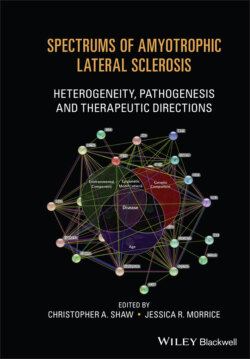Читать книгу Spectrums of Amyotrophic Lateral Sclerosis - Группа авторов - Страница 39
Penetrance and the Oligogenic Hypothesis
ОглавлениеA small percentage of ALS cases carry more than one variant of an ALS gene [81–83]. Moreover, while the penetrance of SOD1, TARDBP, FUS, and C9orf72 variant carriers can reach upward of 95% [84], there are always rare asymptomatic carriers [85]. Often, variants that arise in ALS genes of uncertain penetrance are extremely rare, and it is difficult to calculate the penetrance of a variant that has been observed in a single patient or family [4]. Such observations led to the oligogenic hypothesis in ALS: multiple variants in multiple ALS genes are necessary for ALS.
The oligogenic hypothesis is useful to frame the genetic discussion about ALS, but it should be used in specific circumstances. In patients carrying several variants in ALS genes, the age of symptom onset tends to be significantly earlier [81]. The rapidity and severity of symptoms are also increased with each additional variant observed in ALS genes. However, considering that cases with multiple ALS variants constitute a low percentage (approximately 1%) of all ALS patients [86], and because variants in ALS genes tend to have high predicted severity and effects on cellular function, it is likely that a single variant is sufficient to instigate the disease in most cases. Further, as most oligogenic cases are those with C9orf72 HRE [86, 87], and the HRE is highly penetrant at later ages [84], oligogenic ALS cases likely explain disease severity rather than necessity. To better explore the oligogenic hypothesis, variant penetrance and severity should be considered before labeling a multi‐variant case as oligogenic.
